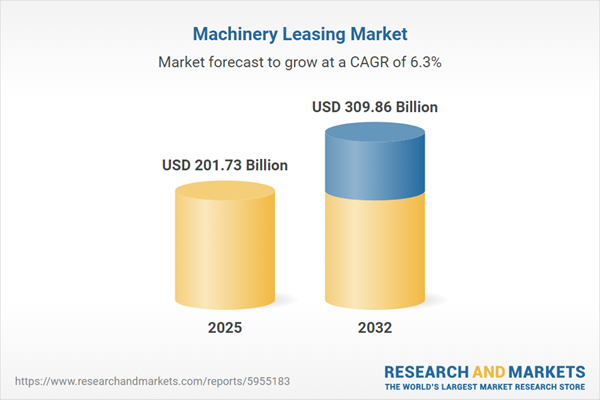Speak directly to the analyst to clarify any post sales queries you may have.
The machinery leasing market is seeing accelerated momentum as organizations rethink equipment procurement strategies amid competitive, technological, and regulatory shifts. This report analyzes how machinery leasing enhances operational flexibility, helps manage capital, and adapts to complex business environments.
Market Snapshot: Machinery Leasing Market Growth and Trends
The Machinery Leasing Market grew from USD 189.70 billion in 2024 to USD 201.73 billion in 2025. It is expected to continue growing at a CAGR of 6.32%, reaching USD 309.86 billion by 2032.
Scope & Segmentation of the Machinery Leasing Market
This report comprehensively examines the evolving landscape across equipment types, end-user industries, and geographies, as well as emerging technologies and business models:
- Equipment Types: Agricultural (harvesters, tractors), construction (cranes, excavators, loaders), industrial (compressors, generators, pumps), and transportation (trailers, trucks).
- End-User Industries: Agriculture (crop production, animal husbandry), construction (commercial, residential), manufacturing (automotive, electronics, food and beverage), mining, healthcare, and oil and gas.
- Lease Types: Finance and operating leases, aligned with different ownership objectives and balance sheet considerations.
- Equipment Age: New and used equipment, shaping entry points and performance expectations for diverse enterprise segments.
- Duration: Long, medium, and short-term lease contracts to match project cycles and organizational needs.
- Payment Terms: Annual, monthly, and quarterly payment structures to help enterprises align cash flow with project demands.
- Geographies: Americas (North America—United States, Canada, Mexico; Latin America—Brazil, Argentina, Chile, Colombia, Peru), Europe, Middle East & Africa (United Kingdom, Germany, France, Russia, Italy, Spain, Netherlands, Sweden, Poland, Switzerland, UAE, Saudi Arabia, Qatar, Turkey, Israel, South Africa, Nigeria, Egypt, Kenya), and Asia-Pacific (China, India, Japan, Australia, South Korea, Indonesia, Thailand, Malaysia, Singapore, Taiwan).
- Key Companies: United Rentals, Inc., Ashtead Group plc, Herc Holdings Inc., Loxam SAS, RSC Holdings, H&E Equipment Services Inc., Neff Corporation, Boels Rental B.V., Ahern Rentals Inc., and Ramirent plc.
Key Takeaways: Strategic Insights for Decision Makers
- Machinery leasing allows businesses to retain agility with minimal upfront investment, supporting dynamic equipment needs in agriculture, manufacturing, and transport.
- Innovative financial models, including usage-based billing and bundled digital services, address both asset obsolescence and operational risks.
- Digital adoption is accelerating, with Internet of Things integration driving predictive maintenance and enhancing value through ongoing monitoring, maintenance, and real-time analytics.
- Sustainability requirements guide portfolio diversification as firms incorporate more electric and low-emission machinery, supported by partnerships with original equipment manufacturers.
- Flexible contract durations and payment structures enable organizations to align costs with specific project lifecycles and market conditions.
- Leading lessors differentiate by offering bundled services, extending warranties, and introducing structured finance innovations such as securitization for balance sheet efficiency.
Tariff Impact: U.S. Trade Policy and Global Supply Chains
Recent U.S. tariffs on critical machinery components have increased complexity in global leasing. Providers are adjusting procurement strategies, pursuing domestic sourcing, and renegotiating vendor contracts to manage cost and maintain competitiveness. These responses reinforce supply chain resilience and underpin long-term portfolio stability in an evolving international trade context.
Methodology & Data Sources
The analysis combines extensive secondary research from peer-reviewed literature, industry publications, and financial disclosures with primary interviews conducted among equipment lessors, OEMs, and senior end-user decision-makers. Quantitative techniques—such as trend mapping and segmentation analysis—are triangulated with expert panels to validate conclusions. This methodology ensures a robust, actionable assessment for market stakeholders.
Why This Report Matters: Actionable Benefits for Senior Leaders
- Provides a holistic framework to evaluate supplier options and refine asset management strategies in fast-changing operational contexts.
- Equips decision-makers with granular segmentation, technology, and regional perspectives to shape targeted investment and procurement decisions.
- Enables competitive benchmarking through insights into leading provider innovations, sustainability measures, and evolving client preferences.
Conclusion
As machinery leasing becomes integral to enterprise strategy, businesses must embrace digital tools, flexible payment models, and resilient sourcing practices. This report delivers essential perspectives to enable alignment of leasing solutions with evolving operational and financial goals.
Additional Product Information:
- Purchase of this report includes 1 year online access with quarterly updates.
- This report can be updated on request. Please contact our Customer Experience team using the Ask a Question widget on our website.
Table of Contents
3. Executive Summary
4. Market Overview
7. Cumulative Impact of Artificial Intelligence 2025
Companies Mentioned
The companies profiled in this Machinery Leasing market report include:- United Rentals, Inc.
- Ashtead Group plc
- Herc Holdings Inc.
- Loxam SAS
- RSC Holdings, Inc.
- H&E Equipment Services, Inc.
- Neff Corporation
- Boels Rental B.V.
- Ahern Rentals, Inc.
- Ramirent plc
Table Information
| Report Attribute | Details |
|---|---|
| No. of Pages | 182 |
| Published | October 2025 |
| Forecast Period | 2025 - 2032 |
| Estimated Market Value ( USD | $ 201.73 Billion |
| Forecasted Market Value ( USD | $ 309.86 Billion |
| Compound Annual Growth Rate | 6.3% |
| Regions Covered | Global |
| No. of Companies Mentioned | 11 |









